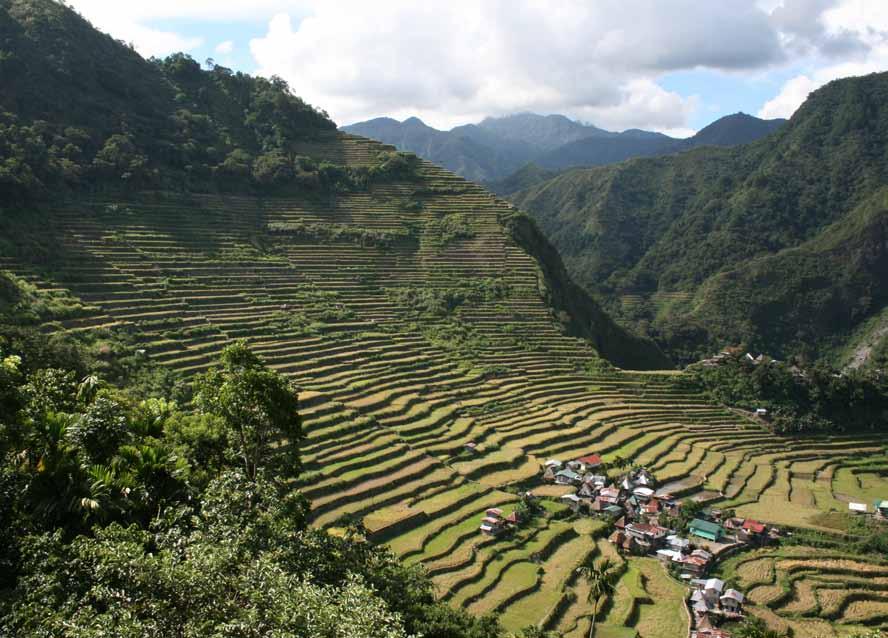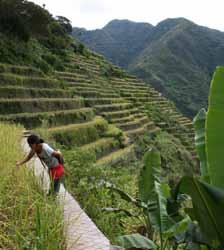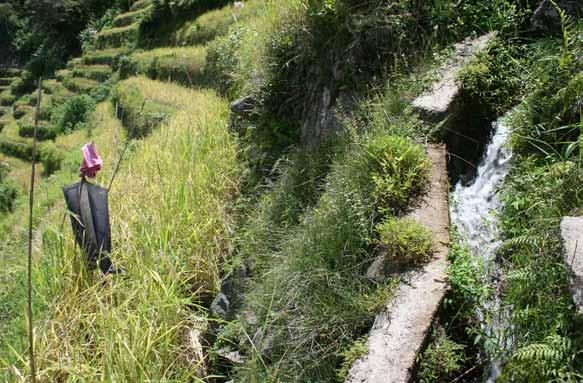
9 minute read
Lessons from the terraces
from March 2020
I news & events LESSONS FROM THE TERRACES
TRAVELS IN THE PHILIPPINE CORDILLERAS
Advertisement
British Landscape architect Charles Lamb travelled to the Philippine Cordilleras to research 2000-year-old water management techniques used by the indigenous tribes.
For over 2000 years, tribes in the high mountain regions of northern Luzon - the Philippine Cordilleras - have developed and managed an irrigation system that captures water, slows its progress, and ultimately provides the lifeblood of the area by irrigating the terraces carved into the hillsides. Could aspects of such a system have contemporary applications, and if so, how practical would it be to translate these to the other side of the world? With these considerations in mind, the Philippines beckoned.
The rice terraces of the Philippine Cordilleras are unique in the Philippines not only for their scale, but also for the way in which they are managed and cultivated by the local tribes. It is thought that the early settlers originated from mainland China, bringing with them their knowledge of terrace construction. In any event, the indigenous tribes have developed and managed a system that utilises the entirety of the

03
02 Irene Binalet, my local guide for my time in Batad, inspecting rice.

03 At the Landscape Architecture Department at the University of the Philippines, Diliman campus, Manila. Left to right: Frank Fontanoza, Avegail Casono, Charles Lamb, Cathe Nadal.

watershed, in particular the high, forested mountainsides above the terraces. This, coupled with an understanding of rain patterns and geology, help them to manage the environment and topography to sustain life in an otherwise seemingly inhospitable, rugged and impenetrable terrain.
In contrast to many other terrace systems that utilise naturally occurring springs as their main source of water, those created in the Philippine Cordilleras access the majority of their water via a managed forest ecosystem (the muyong) a multi-layered forest stretching above and through the cultivated rice terraces. Under usual rainfall conditions, rainwater is absorbed into the ground and gradually percolates downhill, eventually emerging into dedicated channels at the level of the terraces (the kinnaw). These direct the supply as needed to the terraces which, through a system of secondary channels, overflows from one terrace to the next (the kula)
Contentsri sua o effretimovit; nm tim eris trum acta nih esci.retimovit; nm eris trurm eris tru The terraces of Batad are monumental in scale
and purposefully leaky walls, regulates the flow downstream whilst helping to ensure that all terraces are equally irrigated.
In preparation for heading up to the mountains, I met with professors from the Landscape Architecture programme at the University of the Philippines, Diliman campus, in Manila. They too have undertaken their own research on the terrace system.
We discussed whether knowledge gained by the indigenous peoples of the Philippines was being applied to new developments. The consensus was that this was generally not the case: many developments are often short sighted in their outlook in terms of water management systems, and are primarily concerned with moving water away from their development as quickly as possible. Rectification is often only sought after a problem has occurred, usually after a significant flood event. Arguably this could be mitigated by a more sensitive approach to water management from the outset.
I also investigated a water management scheme carried out by a large developer on the Ayala Land Technohub at the University of the Philippines, which utilises swales and retention ponds to capture and absorb significant quantities of rain water on site. However, and from my observations of other developments around the Philippines, using such systems
04


would seem to be the exception rather than the norm. Whilst this particular development had the luxury of space to create such water management systems, the pressure on the existing stormwater network – certainly in Manila – was evident in many a downpour, with roads quickly becoming lagoons as the drainage network proved unable to cope with the volume of water.
Notwithstanding the shortfalls of many modern Filipino developments in terms of their water management systems, that is not to say that the more indigenous methods operating in the Cordilleras are without their own problems. The challenges currently faced by the terrace system, can broadly be split into two: environmental and social issues. Both impact the long term future of the terraces, ranging from more macro themes of an increasingly unpredictable global climate and the pull of work in towns and cities away from agricultural labour, and more localised in terms of the changing ecosystem of the muyong due to variances in maintenance regimes, increased pressures for the cultivation of different crops, and the draw of money to be made from tourism in certain areas of the mountains.
Eventually leaving Manila behind, I headed north. After an overnight bus ride, I arrived in the largest town in the area – Banaue - to be greeted by my incredibly guide, Irene Binalet who is a member of the local Tuwali tribe. Rather appropriately, she also possessed a few terraces which are still farmed for rice.
Wending our way out of Banaue on a motorbike tricycle, we switched up hairpin bends hugging the mountainside and were soon deep into the rice terraces. Inheritance of the terraces in the area operates by age, rather than by primogeniture. The younger siblings, regardless of sex, will often not receive terraces. Instead they may have historically foraged for plants and materials in the muyong, or specifically cleared areas on an ad hoc basis to grow crops or harvest building materials as a way of supplementing their income. This pattern of temporary clearing and periodic harvesting resulted in a multi-layered forest canopy developing, with the consequence of increasing rainwater absorption and helping to further regulate the flow of water from the upper hillsides into the terrace network. However, Irene suggested that such a trajectory in life for the younger siblings is now not so clearly followed, with many seeking other ways to make a living.
The impact of tourism, however, remains relative - to exclaim that your destination is at the end of the road takes on a more literal meaning once into the hinterland of the Cordilleras. This was certainly the case for my journey to Batad, some way outside the main settlement of Banaue, where I based myself for my time in the mountains. The road leading to Batad unceremoniously ends in a jungle clearing, with a final trek along often narrow, washed out paths, accompanied by precipitous drops into the pine and tree fern clad forest below.
The terraces of Batad are monumental in scale, with its setting of a natural amphitheatre revealing itself as you round the final bend on the track. Terraces stretch seemingly impossible distances up and around the hillside. Small, often thatched, houses perched on stilts cluster on the more level parts, with people bent double working in the fields below under the early afternoon sun.
06 Charles Lamb at the terraces of Batad.


PHOTO CREDIT: 05
06
At close quarters with the terraces, the genius of their operating system becomes apparent. A slow, but constant, stream of water either trickled from the muyong along the kinnaw, or flowed from one terrace to another through the kula. Ferns protruded from the damp walls, where water seeped through at a much slower rate, whilst rice ready for harvesting created a wheaten patchwork across the valley. There were however scars in the form of landslides, with terraces having collapsed on each other like dominoes due to the more frequent rains that follows unprecedented periods of dryness.
The Philippine’s government has tried to mitigate further collapses by renewing one of the uppermost retaining walls that border the surrounding muyong above the Batad terraces. Significant amounts of concrete predominate, with only a few plastic pipes protruding through to allow some water seepage. The end result jars with the vernacular, with little acknowledgement of local, more environmentally sensitive construction techniques. The argument for using the concrete was that the entire section of
Contentsri essuam,co effretimovit; nium tim eris trumFacta avernih esci. Volum optili ntentsri essuam,co effretimovit; nium tim eris truVolum optili Challenges faced by people from other times and cultures are often not so dissimilar to our own
hillside was at imminent risk of collapse, and by using concrete the stability of that section was assured, at least in the short term. At present, walls elsewhere in the terraces are yet to be replaced in such a way and are maintained to retain their more porous nature.
Coupled with this, I discussed with Irene whether the periodic collapse of the terraces was compounded by the varying maintenance regimes in the muyong. From her experience this has certainly been the case: as fewer people have cleared areas in the muyong for their own enterprise, a denser, higher level tree canopy has developed at the expense of many of the plants in the medium and lower layers of the canopy. Any rainfall therefore has fewer layers to fall through before reaching the ground, leading to more frequent and high-volume run-offs.
Notwithstanding the issues that the terraces face for their long-term survival, there are some interesting potential applications of how the system operates that could be utilised elsewhere. The potential effect that a multilayered forest canopy has on reducing rainwater run-off is an intervention that could mitigate runoff in areas with the space to implement such a scheme, although it would require ongoing management in order to maximise its efficiencies. The channelling of water to dedicated areas – the terraces themselves in this instance, although possibly equally applicable to retention ponds or similar – allowing for overflow from one basin to the next, could be another application. Similar techniques were used in the UK in Pickering, North Yorkshire, to seemingly positive initial results.
Whilst it may be impractical to try and emulate the highly labour intensive management system that operates in the terraces of the Cordilleras, it should be remembered that the challenges faced by people from other times and cultures are often not so dissimilar to our own, and it would be imprudent to dismiss their techniques out of hand as archaic. Whilst some may prove to be only of historical or cultural interest, the ability of a landscape to survive for two millennia in a tropical, ever changing and challenging environment does provide ideas for how we may adapt our own landscape for a more sustainable future.









